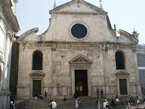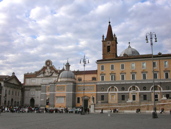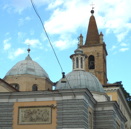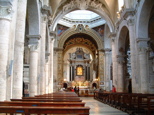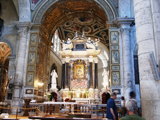Santa Maria del Popolo is a notable
Augustinian church located in Rome. It stands to the north side of the
Piazza del Popolo, one of the most famous squares of the city, between the ancient
Porta Flaminia (one of the gates of the
Aurelian Walls and the starting point of the
Via Flaminia, the road to Ariminum (modern Rimini) and the most important route to the north of Ancient Rome) and the Pincio park.
For reference, a plan of the church is available
here.
In 1099 a chapel was built by
Pope Paschal II to Our Lady over Roman tombs of the the Domitii family. Tradition claims that
Emperor Nero was buried on the slope of the Pincian hill by the piazza. Pope Paschal II had his remains disinterred and thrown into the Tiber at the request of those who lived in the area. The chapel was built were the grave had been.
Since the people of Rome funded the building, the chapel received the name del Popolo ("of the people"). Other sources state that the "popolo" nickname stems from the Latin word populus, meaning "poplar" and probably referring to a tree located nearby. The chapel became a church by will of
Pope Gregory IX (1227-1241), and given to the Augustinians in the first half of 13th century, who held it until now.
Santa Maria del Popolo was reconstructed by
Baccio Pontelli and
Andrea Bregno in 1472-1477, commissioned by
Pope Sixtus IV in association with the
Lombards of Rome, making this one of the first examples of
Italian Renaissance architecture.
In 1655-60 alterations to the façade and the interior were made by
Gian Lorenzo Bernini, who was asked by Pope Alexander VII to update the Renaissance church to a more modern
Baroque style. After Bernini's intervention, the church became a favourite site of burials of rich people of the city. Among the others, the banker
Agostino Chigi and the
Cardinal Savo Millini have their tombs here.
